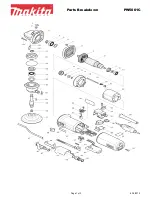
13
Tips for applying polish
●
Apply polish with sweeping straight
line strokes, either side-to-side or
back-to-front (see Fig. 7)
●
Use a thin even coat.
●
Do not use excessive pressure against
the work surface. The random orbit
action works best with little pressure.
●
Each time you add polish to the foam
pad, use less polish to avoid saturating
the pad.
●
Follow specific recommendations of
the polish manufacturer.
REMOVE POLISH
1. Allow polish to dry to a haze.
2.
Remove the 4” foam pad and install
the 6” buffing pad (see Fig. 8).
NOTES:
a) Make sure the foam pad is centred
on the mounting plate.
b) You can also use the 4” foam pad to
remove polish. If you used the 4” pad
to apply polish, it must first be
thoroughly cleaned and dried. See
Maintenance section of this manual for
pad cleaning instructions.
Tips for removing polish
●
Let the tool do the work. Do not apply
excessive pressure when removing
polish.
●
Move the polisher in a figure 8 pattern
over the surface you are polishing.
●
Remove the buffing pad periodically
and shake out the excess dried polish.
Excess dried polish in the buffing pad
will cause streaking.
FINAL BUFFING & POLISHING
After you have removed all the polish,
remove the foam pad and install the 4”
micro fibre pol
ishing pad for a “showroom
shine” (see Fig. 9). Refer to “Tips for
removing polish” above and proceed in
exactly the same manner for the final
buffing & polishing.
Fig. 7
OPERATION
Fig. 8
Fig. 9






































